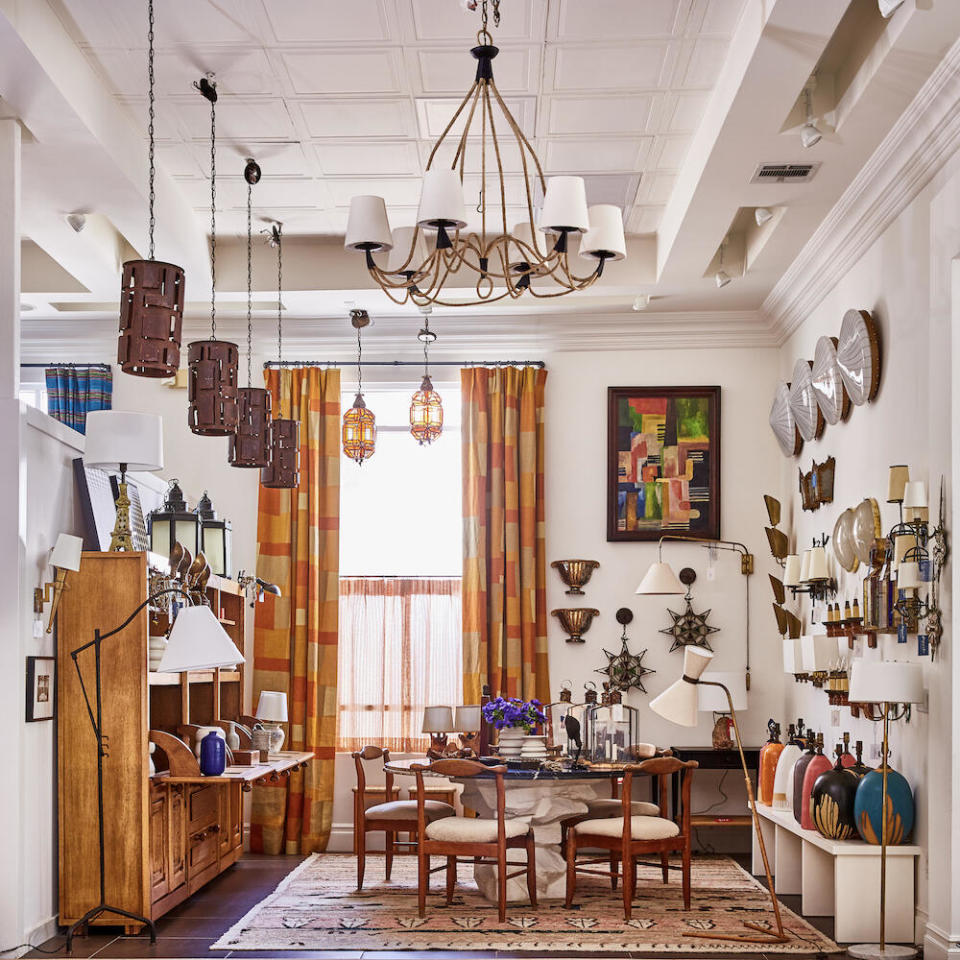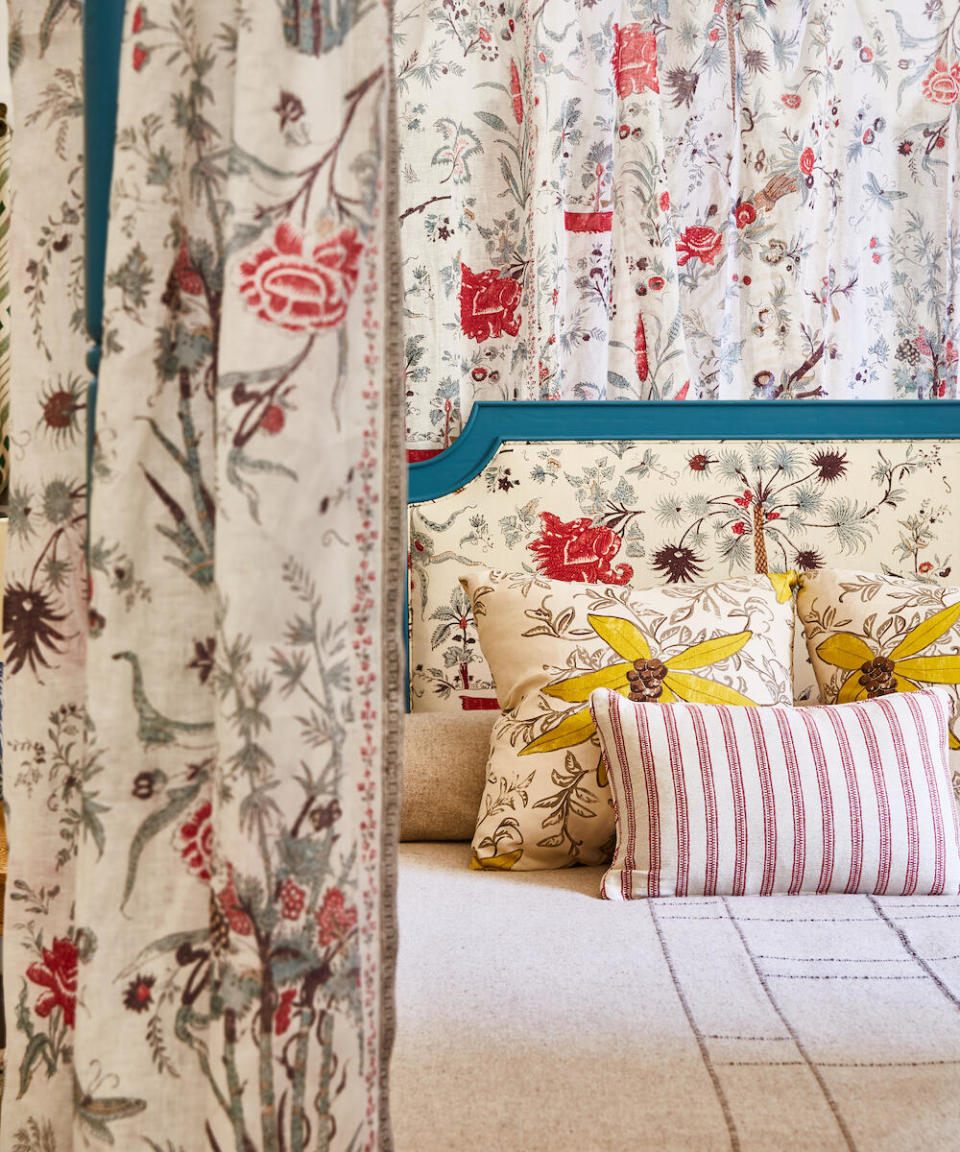How designer Peter Dunham became the textile king of Hollywood

Shop Talk | Sep 13, 2023
In Business of Home’s series Shop Talk, we chat with owners of home furnishings stores across the country to hear about their hard-won lessons and challenges, big and small. This week, we spoke with Peter Dunham of Southern California’s Hollywood at Home shop.
After living in England, France and New York, Dunham launched his interior design studio in Los Angeles in 1998. It was followed by a textile and wallpaper line, and finally, in 2007, a shop. All three aspects of his business are alive and well today. Ahead, he explains how he balances it all (avoiding drugs is key, apparently), the parts he likes best, and how e-commerce has demonstrated there are still ways to grow and change after all this time.

What was your career like before the shop?
I started designing when I moved to L.A. 25 years ago. One of the things I liked very much was doing custom fabrics for clients. I’d always collected textiles, and there were things that at the time I couldn’t get, so I started doing custom. That morphed into doing textiles in India, and then a showhouse [for a publication], and then, before the magazine came out, rushing a collection together [to capitalize on the exposure]. We started producing in the States, and then after a couple of years of eight of us working in 600 square feet, I was like, “You guys have to get out of here with the fabrics.”
The [team] found this space, a little courtyard-y compound. We [converted] it into a showroom-office, and then I thought I’d rope in other friends, like Carolina Irving, John Robshaw and a bunch of other people. Then the recession came in 2008, and [because real estate prices dropped so steeply], we could afford to move to La Cienega Boulevard. We’re now in our third store on La Cienega.
At first, it was primarily a fabric showroom, and I’d put in vintage finds and furniture that I made for clients to give it a vibe. People kept buying the furniture, so that’s how we started a furniture collection. We now have seven lines, [including] furniture, teak produced in Indonesia, accessories and blankets.
So what is the balance of merchandise now?
About 15 percent of our merchandise is vintage, and then third-party textiles, which are Fermoie from England, Penny Morrison, Brier & Byrd, Serena Dugan, Leah O’Connell, Lake August and Tulu. Everything else is proprietary. I only really believe in creating proprietary product for my store. Even the people we do collaborations with—ceramicists or other skills—it’s all exclusive to us.
How would you describe the aesthetic of the showroom?
Relaxed eclectic. It’s got a very California vibe, but California meets France.
How does it compare to other design stores in the area? Because I think now California means everything neutral, everything rattan, and your store is much livelier than that.
I would say Harbinger, across the street, has a similar spin. We’ve always been very good friends and closely allied. Nickey Kehoe is another company quite similar to ours, with a slightly more countryish vibe. I would say ours is 20th century–inspired—1940s, ’50s, ’60s, ’70s—but not glitzy. There’s a feeling of materials and hand-crafted-ness about it, and color.

I like having a mix of furniture, textiles, lighting and accessories, because it keeps people coming back. It’s so tempting now just to have it all online and assume that no one’s coming in, but I think it’s important to have people to shop in person as much as possible.
How much of your customers are trade?
Up to 80 percent of our actual revenue is to the trade. Obviously, we welcome both because the trade spends a lot more than nontrade. But there are a lot of people who come in to find things to finish their house. We have a pretty robust cushion-making program.
What’s the fastest-selling category in the store?
I think 75 percent of people probably come in for textiles. It’s a primary entrance. That aside, the most popular things are probably seating. It’s kind of hard to find interesting seating! Rush, wicker, caning—because that materiality is difficult to replicate elsewhere. A very classic How to Marry a Millionaire chair, which I had from the very first time I opened [the store]—it was from the movie, and I bought it from the Hollywood memorabilia sale. That’s probably still our bestselling item.
I approach [merchandising] from the point of view of the designer who is looking for solutions for problems. One of the problems designers always meet is [finding] end tables and coffee tables that are the right size, height, comfort. Whenever I buy [vintage] end tables, they go very quickly.
Who sources the vintage pieces, and how? And how do you find new artisans to partner with?
I shop for pretty much all the vintage, because it’s one of my favorite things to do. I double time—I shop for clients and for the shop. When a client says, “I’m not sure,” then it goes into the shop. Vintage shopping is very much my pleasure in the whole enterprise of working in design.
In terms of vendors, we’re very lucky in L.A. because it’s the second-largest production area in America. Part of the reason I like making things is having access to great metalworkers, carpenters, cabinetmakers, upholsters who are truly skilled. They approach me, I find them, somebody recommends them. It’s an easy connection.

Elsewhere, [we seek international partners]. For example, we [offer] a lot of blankets woven in Spain, [through] a vendor I found years and years ago, probably at a trade show. A friend in India found weavers using an old technique and put me in touch, and we’ve done these Indian blankets as bed covers, hangings, window treatments or upholstery. We keep coming up with new colors and patterns. We [also] work with some people from Peru. Orli Ben-Dor, my creative director, and I were invited to go to a trade show by the Peruvian government. We said, “OK, can you make this, and can we twist that, and can we do this pattern instead?” There’s a lot of working with and getting inspired by what people are used to making. I went to Guadalajara in February for a furniture trade show, and we found vendors doing carved wood that was really interesting. You say, “Can you make it as a coffee table instead of a little stool?” And then we start discussing. I’m very attracted to the hand-made.
What’s your approach to e-commerce, and how has it changed over the years?
We’re selling more and more furniture, and I’m surprised by where it’s going—to all these parts of America where I don’t even know how they’ve heard of us. Through being published, or Instagram? They will, in the middle of the night, buy barstools, dining tables and dining chairs. I’m amazed by it.
We’re in [the middle of] a big change. You still need to have brick-and-mortar to legitimize your online presence, I believe. You’re kind of spending on one and you’re spending on the other. You want a reputation for fine craftsmanship. We have a very robust online cushion service; people go through our fabrics and order cushions online, and they get it two weeks later. They can redo all the cushions in their living room for an event. [Also, we have] bed covers—we do really well with [anything] easily shippable. I’m saying, in a long-winded way, that shipping is still a very complicated thing for small vendors. It’s a constant challenge for every single one of us who are in the business of shipping furniture to people.
Are there any operating concerns that are specific to the Los Angeles area?
It’s much easier for me to answer with the advantages of being in Los Angeles, because I find it much harder to do things in other places where we’re installing for clients or trying to get things done. You can’t complain about the weather, about freezing winter or overly hot summers. One of the things we’re not well set up for is rain, so things take a long time to finish in winter, when you’re doing wood finishes, for example. You have a much bigger market in New York than you do in Los Angeles. New York seems to capture a third to 50 percent of the trade business in America, and it sometimes feels like we’ve got the leftovers. The shrinking parking situation in Los Angeles is definitely a problem for brick-and-mortar stores. Otherwise, I would say we’re good.

You have so many tentacles to your business. How do you balance it all, especially with travel?
I have three to four [separate] strong teams. I’m very involved in the development, but once the development is approved, I don’t deal with any production. I review the books to make sure we’re not going bankrupt. But honestly, the most complicated challenge we have is traditional interior design. It requires a lot more hand-holding—presence with clients and architects, doing the site visits, [giving] opinions. I’m very lucky that I have really good logistical teams. And you have to [have] that. I can’t take care of everything.
Good hiring is the answer.
Yes. And honestly, I sleep a lot. I don’t do drugs. I don’t drink very much. The advantage of L.A. is you don’t get a hugely distracting social life like you do in New York. So I spend a lot of my awake time dealing with the three different companies, and they overlap so much. Many of the things that we have in the store were originally things that we made for clients, [that] people kept on saying yes to. We think, “OK, I’ve had five clients approve this coffee table. We’re going to start making this.”
What’s your favorite kind of workday, your preferred workload?
I’ve told you I love going vintage shopping. I’m in France [right now] and about to go in for these trade fairs. You get up early, and it’s like a scrum—it’s exhausting and hugely enjoyable. My eyes are constantly roving, like, “What can I do with this? How can I transform it for today?” I love that part.
I love working with the vendors and seeing what they’ve done based on what we discussed. It feels very satisfying, the pure creativity of it. Don’t give me the spreadsheet part. That doesn’t get me super excited. I love making things. I always did. Coming up with a beautiful product is one of my favorite things.
Want to stay informed? Sign up for our newsletter, which recaps the week’s stories, and get in-depth industry news and analysis each quarter by subscribing to our print magazine. Join BOH Insider for discounts, workshops and access to special events such as the Future of Home conference.

